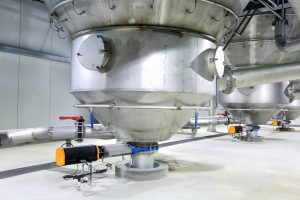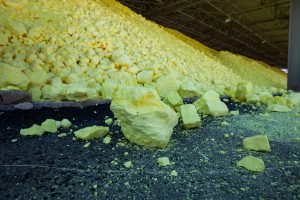What Causes Material Bridging in Hoppers and How AirSweep Can Help
Comments Off on What Causes Material Bridging in Hoppers and How AirSweep Can Help
Material bridging in a hopper can slow down production and reduce bulk storage space. The stagnant material can spoil or become contaminated, and workers have to clear the vessel and throw out compromised batches.
What is material bridging?
Bridging is the material block that forms above the discharge outlet of a hopper, silo, or any bulk material handling equipment.
The bridge is caused by friction on the vessel walls which slows down the flow of material. Eventually, the material particles start to bind and interlock, until it partially or completely blocks the discharge outlet.
The bridge is so strong that it can support the weight of material above it. New material can condense the trapped material further and strengthen the bonds.
Types of material bridging
- Mechanical bridging. Particles mechanically interlock, like jigsaw puzzles. This usually happens for particles that are larger than 3mm.
- Cohesive bridging. Particles compress until they bind together. This usually happens for smaller particles, especially those that attract moisture.
What causes material bridging in the hopper?
Material bridging can be caused by the hopper design, the material’s flow properties, and the conditions in the plant.
Hopper Design
Ideally, the hopper design should reduce friction and encourage flow. However, there is no one-size-fits-all solution. Solids and liquids behave differently, and materials have unique properties that can also vary in different conditions. These factors have to be considered while choosing the hopper’s angle, and the outlet’s shape and diameter.
Material Properties
Some materials are simply more prone to bridging and arching. This includes:
- Moist and sticky materials
- Materials that tend to settle during storage
- Materials with a high cohesive strength
- Hygroscopic powders that attract moisture
- Pellets that soften and form soft clumps
- Fibers that can entangle
- Irregular particles that can interlock
- Heavy materials that can push down on stagnant material and cause it to compress
Plant Conditions
Fluctuating temperatures can affect the stress on the hopper walls and the material flow properties. Moisture in the air can cause materials to expand and compress. Gas in the air can also permeate through powders and fill empty spaces.
The best solution for material bridging in the hopper
Flow aids solve bridging and other material blocks by breaking up the cohesive bonds in the material. However, not all flow aids can do this safely or effectively.
Manual cleaning—where workers hammer the vessel or enter the hopper to clear the build-up with axes and shovels—is slow and dangerous. Some materials release flammable or toxic gases during storage. Workers are also at risk for falls, sprains, health problems from direct exposure to the material, or being hit by falling material.
Vibrators can damage the vessel and can cause some materials to become more compact. Fluidizers can only activate light powders; air cannons are expensive and still leave material residue on walls.
AirSweep is the most cost-effective solution for material bridging in hoppers. It releases powerful air pulses that break up bridging and sweep stagnant material back into the flow stream.
AirSweep engineers customize the system so the units are installed at key areas on the hopper to stimulate first-in/first-out flow. They select the right model for the material and the vessel size. The AirSweep USDA-accepted model is also specially designed for sanitary applications like food, beverage, and pharmaceuticals.
The AirSweep system is energy-efficient. It uses less air than air cannons, and the units pulse in sequence instead of running continuously like vibrators and fluidizers. The units also have a large area of activation and move more material with every pulse.
Find more information about AirSweep, or get a customized quote.
Solve Common Problems When Handling Bulk Materials
Comments Off on Solve Common Problems When Handling Bulk Materials
Every industry uses dry bulk materials—whether it be chemical powders, pellets, flakes, mined minerals, raw materials, food, additives, stabilizers, or preservatives.
Each of these materials has its own properties that can affect how they behave while being stored, transported, or processed. And when you’re dealing with tons of materials, the stakes become higher. Any problems will incur huge delays and costs.
Bulk material handling (BMH) equipment can help prevent dry bulk materials handling issues, and improve production efficiency. The right equipment can even help lower costs, and increase plant safety.
Control Concepts, Inc.: Your Partner in Bulk Material Handling
Since 1951, we have helped companies resolve dry bulk materials handling issues. The patented technologies are used in every industry: mining, cement, food, pharmaceuticals, chemicals, mined minerals, and more.
We offer three products for bulk material handling: AirSweep pneumatic flow aids, DAZIC zero speed switches, and AcoustiClean sonic horns. Each of them addresses particular dry bulk materials handling issues to prevent delays, unnecessary costs, and safety risks.
AirSweep for on-demand material flow
Poor material flow is one of the most common dry bulk materials handling issues—and the most problematic. Sluggish flow (or even no flow) can:
- Slow down production
- Compromise batch consistency
- Cause contamination and spoilage
- Lower vessel capacity
- Increase material waste
- Create flammable environments
AirSweep uses powerful air pulses that break up material blocks and sweep stagnant material back into the flow stream. Unlike other flow aids like vibrators and air cannons (or the old-fashioned method of hitting the vessel with a hammer), it does not cause metal fatigue.
AirSweep has been proven effective for all types of dry bulk materials, including damp powders, plastic flakes, fibers like tobacco, pellets, and irregular particles like mined materials. It also has lower energy and maintenance costs than other flow aids, and can easily be removed from the vessel for cleaning with simple tools.
DAZIC zero speed switch to prevent material pileup
If a conveyor belt or bucket elevator fails, tons of material can spill over and pile up. Workers will need days to clean it up, and companies will need to face production losses and additional manpower costs.
Spilled material can also create safety risks, especially if it is heavy, flammable, or classified as a toxic chemical. That is why OSHA and other safety organizations require plants to take precautionary measures for machine failure and spills.
DAZIC zero speed switches are very affordable but can prevent very expensive and dangerous material pileups. They are attached to equipment to detect any abnormal change in rotation speed. If the equipment speeds up, slows down, or stops completely, DAZIC sends a signal to the operator to shut it down.
DAZIC can be attached to any bulk material handling equipment with a rotating shaft, such as
- Rotary valves
- Bucket elevators
- Belt, drag, and screw conveyors
- Fans
- Blowers
- Saw blades
- Drive motors
- Mixers
- Crushers
- Agitators
- Rolling mills
AcoustiClean Sonic Horns to clear light material buildup
Light powders can accumulate on surfaces and hard-to-reach areas. This can cause contamination issues, affect the efficiency of the vessel, or create potentially flammable environments.
AcoustiClean Sonic Horns produce high-energy, low-frequency sound vibrations that disperse dry material. Compressed air is applied to a sound generator, which vibrates a titanium diaphragm. The sound waves clear the material, to clean your material handling equipment.
AcoustiClean can be integrated into the system to automatically clean the surface between production runs. It reduces plant shutdowns, prevents cross-contamination during production, replaces dangerous and expensive manual cleaning, and improves energy/heat transfer efficiency and lifespan of machines.
Bulk Material Handling Solutions
AirSweep, DAZIC, and AcoustiClean can prevent many dry bulk materials handling issues. For more information, or to get a customized quote contact us.




